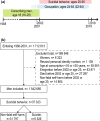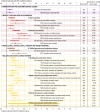Occupational groups and risk of suicidal behavior in men: a Swedish national cohort study during 2002-2019
- PMID: 39696130
- PMCID: PMC11657517
- DOI: 10.1186/s12889-024-20887-x
Occupational groups and risk of suicidal behavior in men: a Swedish national cohort study during 2002-2019
Abstract
Introduction: The risk of suicide has been shown to vary by occupation. We aim to identify contemporary occupational groups at greatest risk for suicidal behaviour (fatal and non-fatal), in Swedish men of working-age.
Methods: A population-based cohort study of male conscripts without history of self-harm who enlisted during 1968-2001 and were followed-up during 2002-2019 (n = 1 542 665). Occupational groups and suicidal behaviours were identified using national registers. Incidence rate ratios (IRR) for suicidal behaviour at ages 25-65 were calculated among occupational groups, and compared to the incidence rate of the whole cohort.
Results: Major occupational groups with increased risk for suicidal behavior included elementary occupations, building and manufacturing, service, care and shop sale and mechanical manufacturing and transport. Subgroup analyses revealed particularly high risks for assistant nurses, other service workers not elsewhere classified, building frame and related trades workers and cleaners and helpers.
Conclusions: Men with elementary occupations as well as personal care and building and manufacturing workers were at greatest risk. This study provides a comprehensive description of risks for suicidal behaviour among occupational groups in men of working-age. These results suggest occupational groups that should be targeted for general suicide prevention intervention.
Keywords: Epidemiology; Incidence rate ratio; Risk assessment; Self-harm; Suicide; Work-related.
© 2024. The Author(s).
Conflict of interest statement
Declarations. Ethics approval and consent to participate: All procedures involving human subjects were approved by the Ethics Committee of the University of Gothenburg (462–14) and Confidentiality Clearance at Statistics Sweden. Given that all data used was psuedonymized and coded by Statistics Sweden, informed consent to participate was not obtained from the participants. Consent for publication: Not applicable for Swedish register-based studies, as the contribution of personal data to research is included in the contract between Swedish residents and the Swedish state provided that the research is ethically conducted [36]. The Ethical committees in Sweden are generally acknowledged to represent the public, and approval from an Ethical committee can largely replace individual approvals from study participants in registry-based research. As stated by Ludvigsson et al. [36], the arguments that informed consent is not needed for registry-based studies in Sweden include: 1) Many research proposals would be impossible due to the sheer number of study participants (over 1 million participants); 2) It would dramatically reduce rate of participation and statistical power of most nationwide population-based studies, and lessen the scientific validity; 3) Risk for selection bias, since consent would be notably harder to obtain in high-risk groups, where positive outcomes are most frequent; 4) Individuals with registry-based information will be dead when the study is performed, and thus, consent is impossible; 5) Most large-scale research would be prohibited due to the extreme costs of obtaining the consent of millions of individuals with health data. Competing interests: The authors declare no competing interests.
Figures





Similar articles
-
Occupation-specific risk estimates for suicide and non-fatal self-harm from a Swedish cohort of male construction workers followed 1987-2018.Occup Environ Med. 2024 Mar 8;81(3):142-149. doi: 10.1136/oemed-2023-109246. Occup Environ Med. 2024. PMID: 38418223 Free PMC article.
-
Short term risk of non-fatal and fatal suicidal behaviours: the predictive validity of the Columbia-Suicide Severity Rating Scale in a Swedish adult psychiatric population with a recent episode of self-harm.BMC Psychiatry. 2018 Oct 1;18(1):319. doi: 10.1186/s12888-018-1883-8. BMC Psychiatry. 2018. PMID: 30285661 Free PMC article.
-
Psychosocial job stressors and risk of suicidal behavior - an observational study among Swedish men.Scand J Work Environ Health. 2022 Sep 1;48(6):435-445. doi: 10.5271/sjweh.4039. Epub 2022 Jun 8. Scand J Work Environ Health. 2022. PMID: 36044924 Free PMC article.
-
Prevention of suicide and attempted suicide in Denmark. Epidemiological studies of suicide and intervention studies in selected risk groups.Dan Med Bull. 2007 Nov;54(4):306-69. Dan Med Bull. 2007. PMID: 18208680 Review.
-
Association Between Atopic Dermatitis and Suicidality: A Systematic Review and Meta-analysis.JAMA Dermatol. 2019 Feb 1;155(2):178-187. doi: 10.1001/jamadermatol.2018.4566. JAMA Dermatol. 2019. PMID: 30540348 Free PMC article.
References
-
- Milner A, Spittal MJ, Pirkis J, LaMontagne AD. Suicide by occupation: systematic review and meta-analysis. Br J Psychiatry. 2013;203(6):409–16. - PubMed
-
- Agerbo E, Gunnell D, Bonde JP, Mortensen PB, Nordentoft M. Suicide and occupation: the impact of socio-economic, demographic and psychiatric differences. Psychol Med. 2007;37(8):1131–40. - PubMed
-
- Burnett ACR, Wong Q, Zeritis S, Deady M, Torok M. Occupational class suicide risk: 12-year study of national coronial data. Br J Psychiatry. 2023;222(6):234–40. 10.1192/bjp.2023.22. - PubMed
MeSH terms
LinkOut - more resources
Full Text Sources

